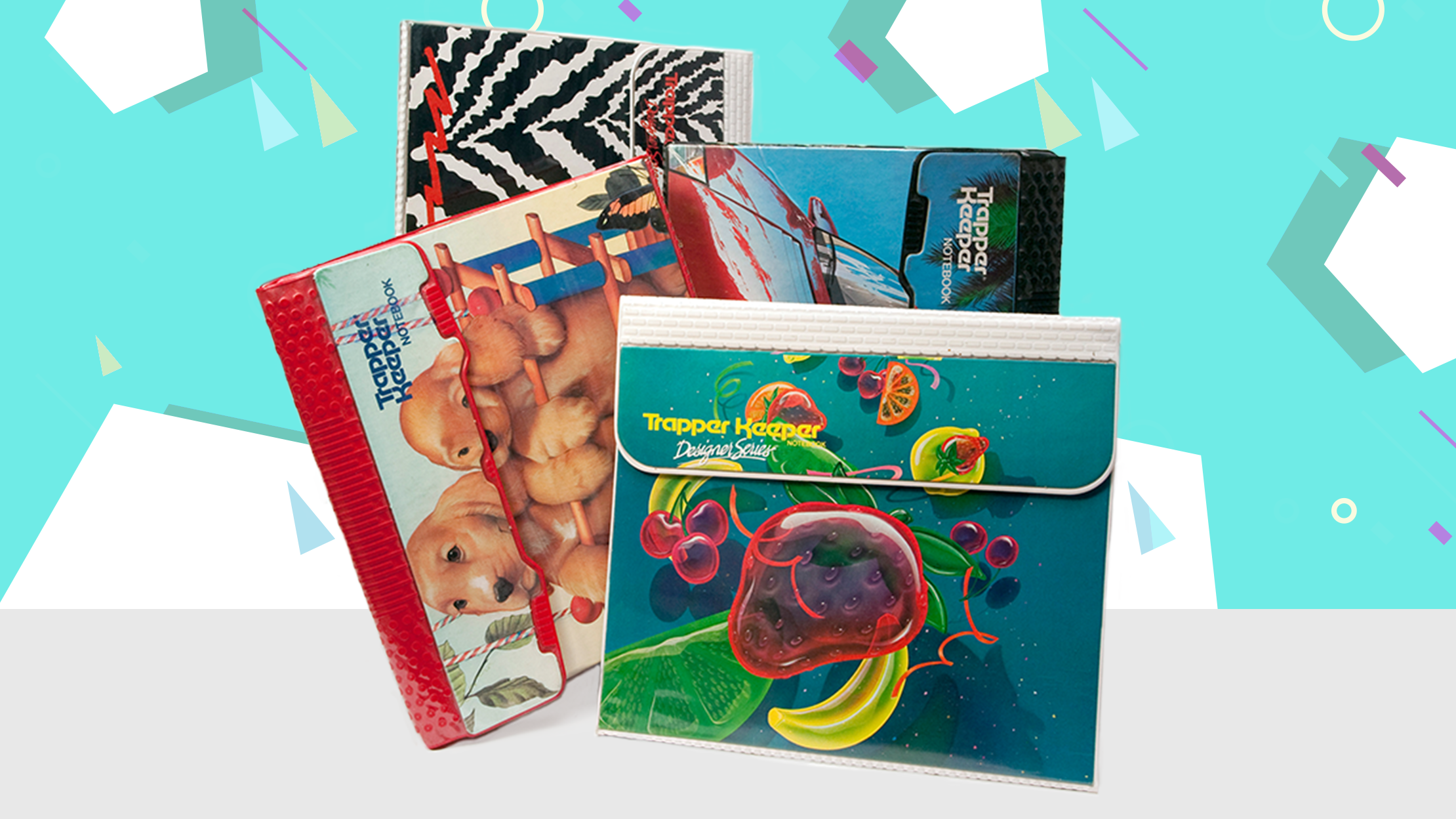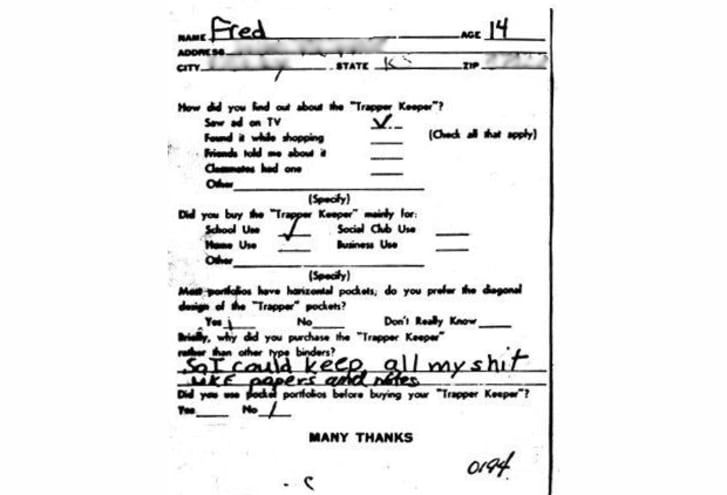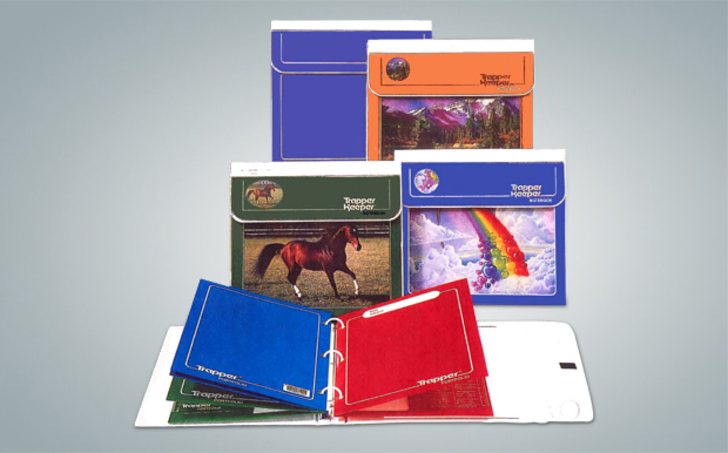The Trapper Keeper (2017)

When E. Bryant Crutchfield began test-marketing his new school notebook in 1978, he thought it would be useful to insert a feedback card into each one. Kids who purchased the organizer—which Crutchfield called the Trapper Keeper—found a slip that promised them a free binder if they mailed in their comments.
Approximately 1500 cards were returned. Under “Why did you purchase the Trapper Keeper rather than another type binder?” respondents said things like:
“I heard it was good. My girlfriend had one."
"So when kids in my class throw it, the papers won't fly all over."
"My mother got it by mistake but I'd seen it on TV, so I decided to keep it."
"Instead of taking the whole thing you can take only one part home."
"Because they keep your papers where they belong. They're really great—everybody has one.”
But Crutchfield’s favorite comment came from a 14-year-old named Fred. Fred wrote that he had bought the Trapper Keeper rather than another binder to “keep all my shit, like papers and notes.”

“Kids that age are very open and honest,” Crutchfield chuckles.
Launched in 1978 by Mead (now part of ACCO Brands), Trapper Keeper notebooks were a departure from the sterile, generic supplies that populated school lockers and desks. Brightly colored three-ring binders held folders called Trappers and closed with a satisfying button snap. From the start, they were an enormous success: For several years after their nationwide release, Mead sold over $100 million of the folders and notebooks a year. To date, more than 75 million Trapper Keepers have flown off store shelves.
But in the late 1970s, the people at Mead couldn’t have known that their product would eventually garner such cultural significance. In fact, Crutchfield was just looking for the next back-to-school item, and he did it the old-fashioned way—through market research. "[The Trapper Keeper] was no accident," he tells Mental Floss. "It was the most scientific and pragmatically planned product ever in that industry." In a sense, the Trapper Keeper became one of the few influential designs that represented the ideas, needs, and impressions of the masses. Kids like Fred were part of a creative committee that helped generate one of the most enduring organizational products of all time.
SITUATION ANALYSIS
As director of New Ventures at Mead, part of Crutchfield’s job was to identify trends in the marketplace. In 1972, Crutchfield’s analysis, conducted with someone at Harvard, showed there would be more students per classroom in the coming years. Those students were taking more classes, and had smaller lockers.
Fast forward a few years, when Crutchfield’s analysis revealed that sales of portfolios, or folders, were increasing at 30 percent a year. Thinking back to that Harvard report, a lightbulb went off. “You can’t take six 150-page notebooks around with you, and you can’t interchange them,” Crutchfield says. “People were using more portfolios, so I wanted to make a notebook that would hold portfolios, and they could take that to six classes.”
Crutchfield was speaking with his West Coast sales representative about what he planned to do when another piece fell into place. Portfolios in notebooks were a great idea, the rep said, but why not make the pockets vertical instead of horizontal?

Folders with vertical pockets, called PeeChees (as in, peachy keen), had been around since the 1940s and were sold on the West Coast, but they had never made the leap across the Rockies—so Crutchfield was doubtful. “I said, ‘They only sell on the West Coast, and what’s the real benefit of a vertical pocket?’” Crutchfield remembers. “[The rep] said, ‘When you close it up, the papers are trapped inside—they can’t fall out. If you’ve got a horizontal pocket portfolio, you turn it upside down, and zap! [The papers] fall out.’”
Crutchfield was convinced and got to work. First, he took sketches of the portfolios and notebooks to a group of teachers to find out if there was truly a need for that kind of thing. The group said that student organization was a major problem, and the teachers would welcome any product that would help in that regard.
Next, Crutchfield created a physical mock-up. Unlike the PeeChee—which had straight up-and-down vertical pockets—Crutchfield’s portfolios had angled pockets, with multiplication tables, weight conversions, and rulers on them. “It was like a textbook inside,” he said. Then he designed a three-ring binder that held those portfolios and closed with a flap. Students could drop the notebook, and the contents would stay securely in place.

So Crutchfield had a mock-up of his product, but he still didn’t have a name. That came from his research and development manager, Jon Wyant. “I said, ‘I need a name for this damn thing. Have you got any ideas?’” Crutchfield remembers. The next day, they were drinking a martini with lunch when Wyant said, "Let’s call the portfolio the Trapper."
"What are we going to call the notebook?" Crutchfield asked. "The Trapper Keeper,” Wyant replied.
"Bang!" Crutchfield says. "It made sense!" And that was that.
TESTING THE MARKET

With his product named, and a prototype created (the “Trapper Keeper” logo stuck on in press-on-type, and the design—soccer players—held on with tape), Crutchfield went to the next step: more focus group testing. He and other Mead representatives went to schools with the Trappers and Trapper Keeper, talking to students and teachers to get feedback. He also looked for input a little closer to home, from his 13-year-old daughter and 15-year-old son: “I had access to what they were doing in school,” he says, “and I saw their lockers and talked to their teachers.”
For about a year, Crutchfield conducted interviews and focus groups, tweaking the design of the Trapper Keeper along the way. “There were probably five or six iterations,” he says. And once he was happy with the result—a PVC binder with plastic, pinchless rings (they slid open to the side instead of snapping open), a clip that held a pad and a pencil, and flap held firmly closed by a snap—it was time to run a test market, which would help them determine if the product was truly viable.

Prior to the test, Crutchfield wrote a commercial and flew from Dayton, Ohio—where Mead (and now ACCO) was based—to Manhattan, where he hired three actors and filmed the clip for a mere $5000 in just three hours. He was short on cash, so it had to get done—but getting it done wasn't easy. One actor in particular was having a tough time. “It was very straightforward—the kid had a notebook in his arms, and his papers fell out [when a cute girl came over],” Crutchfield says. “We were about 20 minutes away from when the camera goes off [when] he finally got it. I said ‘Wrap!’ and that was it.”

The chosen test market was Wichita, Kansas. In August 1978, Mead aired the commercial there and rolled out its Trapper portfolios and Trapper Keepers. What happened next was unexpected: “It sold out completely,” Crutchfield says.
Inside each Trapper Keeper (which came with a few Trapper folders) was a feedback card; if kids sent it in, Mead would send them a free notebook. Approximately 1500 cards were returned, and they revealed that it wasn’t just kids buying the Trapper Keepers: Adults were also buying it for record and recipe keeping.
After reviewing the test market results, it was clear that Mead had a hit on its hands. Crutchfield told Bob Crandall, the regional sales manager, “This just might be the most fantastic product we’ve ever launched. I think it’s really going to shake up the school supplies market.”
GOING NATIONAL
The company decided to roll out Trappers and Trapper Keepers nationally in the summer of 1981. To prep, Mead created a prime-time network television campaign—a pretty unusual thing for a school supply. They also ran ads in print featuring Mrs. Willard, a 9th grade teacher from Wellington, Kansas, who had recommended the Trapper Keeper to her students during the product’s run in the test market. In the ad, she summed up the benefits of using the Trapper Keeper:
“Most students keep the Trapper Keeper in their locker. Then, they just change Trappers from class to class. With no large notebooks to carry around, they travel light and easy. After school, they take the Trapper Keeper home with all the Trappers inside.”
The folders came in three colors (red, blue, and green) and kids had six Trapper Keeper options: three solid colors and three designs—soccer, dog and cat, and Oregon coast, which were stock photos that Crutchfield bought from an agency. The Trappers had a suggested retail price of 29 cents each, while the Trapper Keepers had a suggested retail price of $4.85.
“We rolled it out, and it was just like a rocket,” Crutchfield says. “It was the biggest thing we’d ever done. I saw kids fight over designs in retail.”
GROWING AND CHANGING

In its third year on store shelves, Trapper Keeper sales were still going strong. It was at that point that Mead made a design change, replacing the metal snap with Velcro. Crutchfield created a prototype for that, too, and pulled it out of his attic for his conversation with Mental Floss. “The only difference is that it’s got Velcro stuck on there, and it’s dusty!” he says. The cover design was a waterfall—a photo Crutchfield had snapped himself in the mountains of North Carolina.
Even though Velcro was a hot material at the time, replacing the snap with it made sense for a lot of reasons beyond that, Crutchfield remembers. One was the fact that “people had trouble finding the center of the snap to snap it,” he says. The other had to do with manufacturing. “Snaps were a lot harder—you have to put [the binder] through a machine twice to put the snap in there. Velcro was a lot easier to apply.”
Though the Trapper folders remained virtually unchanged through the years, the Trapper Keeper evolved as student needs evolved. That evolution included new designs—everything from cool cars to unicorns—which were introduced annually.

In 1988, Mead introduced the Trapper Keeper designer series—fashionable, funky, and sometimes psychedelic designs on the binders and folders that ran until 1995. “Mead employed a large amount of local illustrators to provide early artwork,” Peter Bartlett, former director of product innovation at ACCO Brands and now a professor of design management at Savannah College of Art and Design, tells Mental FLoss. The company also made a deal with Lisa Frank and put her designs on Trappers and Trapper Keepers, and licensed iconic characters like Garfield and Sonic the Hedgehog for the binders. Even Lamborghini got in on the action, granting its blessing to put some of its cars on the Trapper Keeper.
Of course, anything as popular as the Trapper Keeper will almost inevitably face a backlash—but in this case, the backlash didn’t come from students. Crutchfield remembers that some teachers complained about the multiplication and conversion tables, which they said could help students cheat. "It was a controversy at one time," he says. "One teacher said, 'Hell, we can take the portfolios away from them while they’re doing their tests.' Most of the teachers were very honest and said, 'Anything that helps me pound it in their head is good.'"
Mention Trapper Keepers to your friends, and you'll inevitably hear from someone who desperately wanted one, but couldn't have it because it was banned by their school. “The Trapper Keeper started to show up on some class lists as a ‘do not purchase’ because [teachers] didn’t like the noise of that Velcro,” Bartlett says. "[So] we switched from Velcro back to a snap."
But in some cases, what the binders that schools were calling Trapper Keepers and banning weren’t actually Trapper Keepers. “Our research has shown that what they’re calling Trapper Keepers, [are actually] these big sewn binders that are three to four inches thick and can’t fit into a small school desk," Bartlett says. "That’s the reason they’re on the list. When you show [the teachers] a real Trapper Keeper, with a very slim, one-inch ring fixture, it’s like, ‘Oh no, that’s not what I’m talking about. I don’t have any problem with that!’”
Though it became less popular after the mid-1990s, the Trapper Keeper has remained an important part of Mead’s back-to-school line of products—though it has undergone some modifications. “The main change is that we went away from PVC, as most health-conscious companies are trying to do,” Bartlett says. “So it looks slightly different because it’s made out of polypropylene and sewn fabric, but the function is essentially the same.” One line, which was introduced in 2007 and available for a year, was even customizable. “They had a clear piece of plastic in the front,” says Richard Harris, former program manager of industrial design at ACCO. “There was a printed pattern behind it, but then you could put whatever you wanted in that clear sleeve in the front.”
But the cool, psychedelic designs of the early 1990s aren’t as big a focus in the Trapper Keeper line these days. “Trapper has evolved a little bit to relying strongly on a color coding system of organization for students,” Bartlett says. But it's not all work and no play: After a product relaunch in 2014, the company added new Trapper Keeper designs, including Star Wars and Hello Kitty, in 2015.
THE TRAPPER KEEPER'S LEGACY
So why, exactly, do people still love the Trapper Keeper, many decades after they last had one? For Bartlett, it all boils down to what the Trapper Keeper allowed kids to do—and he's not talking about keeping organized. “It was fun to be able to show your personality through the binder that you had,” Bartlett says. “You don’t really remember a notebook or the pens and pencils you used. But maybe you remember your [Trapper Keeper].” Harris says that the binder "wasn’t a regular school product. When you got it, it was almost like a Christmas present. You were excited to have it."
It’s also a prominent pop culture touchstone: Trapper Keepers have been featured on Family Guy, South Park, Full House, Stranger Things, and Napoleon Dynamite. They were transformed into a Trivial Pursuit game piece. John Mayer called Trapper Keepers “the genesis of OCD for my generation.”
These organizational devices would come to define childhoods across North America, and adults who had them remember their Trapper Keepers fondly. (And those who didn’t have them often remember exactly which one they wanted.) Joshua Fruhlinger at Engadget called it “the greatest three-ring binder ever created … Trapper Keepers—the way they combined all of one's desktop tools—were an early incarnation of the smartphone.” There is robust business in vintage Trapper Keepers on eBay, where unused binders with tags start at $150 (those in good condition are priced at $75).

But even the man who invented it all can only guess at why his product became more than just a school supply to a generation of kids. "When I first went to work, all school products were drab and boring," Crutchfield says. "[Trapper Keepers were] more functional and more attractive, with oodles of choices—therefore fun to have. And I had a lot of fun making them fun!"

This story originally appeared in 2013.
from Hacker News https://ift.tt/1a7J3Yh